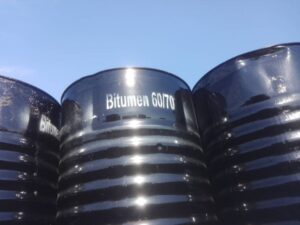Bitumen penetration grade 60/70 is a semi-hard type of grade bitumen extensively used in road construction and repair. This specific grade serves as a fundamental material in producing asphalt pavements and various bituminous products due to its distinct technical specifications. Its characteristics are determined by penetration and softening point tests.
extensively used in road construction and repair. This specific grade serves as a fundamental material in producing asphalt pavements and various bituminous products due to its distinct technical specifications. Its characteristics are determined by penetration and softening point tests.
This grade of bitumen is chiefly utilized in creating hot mix asphalt for base and surface courses. TR6 Penetration Grade bitumens, designated by their penetration range, exhibit thermoplastic properties, softening at higher temperatures and hardening at lower ones, influencing parameters like adhesion, rheology, and durability
Properties of Bitumen 60/70
Properties of Bitumen 60/70 encompass a higher boiling point and heaviness, derived from the vacuum distillation of crude oil. It comprises asphaltene and maltene fractions—where asphaltene lends body and softening points, while maltene provides flexibility. Asphaltene is soluble in aromatic solvents like toluene but insoluble in heptane, while maltene is less aromatic and heptane-soluble. TR6 Petro produces pure petroleum-grade bitumen from vacuum bottom by hot air treatment.
Bitumen 60/70 boasts a penetration range between 60 to 70 desi-millimeters and a softening point of 49 to 56°C. Its thermoplastic nature resembles synthetic resin, displaying considerable viscosity compared to other grades.
Here are some key properties of Bitumen 60/70:
- Penetration: This measures the consistency or hardness of the bitumen. Bitumen 60/70, as denoted by its name, falls within a specific penetration range between 60 and 70 deci-millimeters. This value is obtained through a standard penetration test and indicates how easily a standard needle penetrates the bitumen sample.
- Viscosity: Viscosity refers to the thickness or flow resistance of bitumen at a given temperature. Bitumen 60/70 has a moderate viscosity, allowing it to be easily mixed and applied during construction while maintaining stability under traffic loads.
- Softening Point: This property determines the temperature at which bitumen becomes soft enough to allow penetration by a standard needle. For Bitumen 60/70, this temperature ranges between 49 and 56 degrees Celsius. It indicates the temperature susceptibility of the bitumen and its performance under different weather conditions.
- Ductility: Ductility refers to the ability of bitumen to stretch without breaking. Bitumen 60/70 should possess sufficient ductility to withstand deformation caused by traffic loads and temperature fluctuations without cracking.
- Flash Point: The flash point is the lowest temperature at which bitumen vapors can ignite when exposed to an open flame or spark. This property is crucial for safety considerations during storage, transportation, and application of bitumen.
- Solubility: Bitumen 60/70 should have a specific solubility in trichloroethylene or another suitable solvent. Solubility is an indicator of the purity of the bitumen and its compatibility with other materials used in road construction.
- Density: Density measures the mass per unit volume of bitumen. It affects the overall weight of the asphalt mixture and can influence its mechanical properties.
- Adhesion: Adhesion refers to the ability of bitumen to bond with aggregates (such as stones and sand) to form a durable asphalt mixture. Adequate adhesion ensures that the road surface remains intact under the stresses of traffic.
- Rheological Properties: Rheological properties describe the elastic and viscous behavior of bitumen under different temperatures and stress conditions. These properties are crucial for predicting its performance in various climates and traffic conditions.
- Oxidation Resistance: This property relates to the bitumen’s ability to resist oxidation and aging due to exposure to air, sunlight, and environmental factors. Oxidation resistance contributes significantly to the longevity of the asphalt pavement, ensuring durability over time.
Uses of Bitumen 60/70
Bitumen penetration grade 60/70 stands as the most prevalent type in the bitumen industry. Its distinctive thermoplastic characteristic allows it to soften under higher temperatures and solidify when exposed to lower temperatures. This unique relationship between temperature and viscosity is pivotal in determining performance parameters across a myriad of applications in the global bitumen market.
This grade of bitumen serves extensively across various domains:
- Adhesive: Its adhesive properties make it invaluable in various bonding applications.
- Joint Sealant: Used for sealing joints and crevices, ensuring structural integrity.
- Waterproofing Agent: Applied to surfaces to make them resistant to water penetration.
- Damp Proofing: Acts as a barrier against moisture, preventing its ingress into structures.
- Road Construction and Maintenance: Fundamental in creating and upkeeping roads and airfields.
- Pool Lining: Utilized to line pools, ensuring water retention and durability.
- Soundproofing and Acoustic: Applied in sound barriers and acoustic solutions.
- Pipe Coating: Used to coat pipes for corrosion resistance and longevity.
- Painting: Used in certain paint formulations for specific properties.
Bitumen 60/70 finds extensive use in manufacturing hot mix asphalt for bases and surface courses in road construction. Its versatile nature allows for diverse applications: high penetration bituminous asphalt, softer and commonly used in cold weather, while low penetration asphalt, harder, is suitable for warmer climates.
This grade’s adaptability, coupled with its varied uses across a broad spectrum of industries, makes it an indispensable material in construction, infrastructure development, and various specialized applications worldwide
Specification of Bitumen Penetration Grade 60/70
| Bitumen 60/70 | Test method | Unit | Specification |
| Specific gravity @ 25°C | ASTM D70 | Kg/cm3 | 1.01/1.06 |
| Penetration @ 25°C | ASTM D5 | mm/10 | 60/70 |
| Softening point °C | ASTM D36 | °C | 49/56 |
| Ductility @25 °C | ASTM D113 | cm | 100 min |
| Loss on heating(wt) % | ASTM D6 | wt % | 0.2 max |
| Drop in penetration after heating % | ASTM D5 | % | 20 max |
| Flashpoint °C | ASTM D92 | °C | 250 min |
| Solubility in Trichloroethylene | ASTM D2042 | wt % | 99 min |

